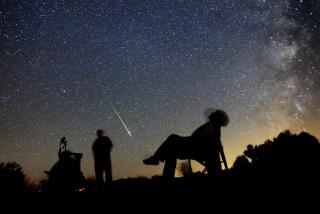A Lifelong Love of Night Sky Is Captured on Film
- Share via
The camera captured a heavenly sight--Comet Hale-Bopp, shining brightly in the desert night sky, floating away from the viewer.
From the desert floor, the eye behind the camera saw the comet just to the left of a red-rock formation in the foreground. That mysterious image was named picture of the year by Time magazine in 1997.
But the photograph--and others seen by schoolchildren and astronomy buffs around the world--was not the work of a scientist or an astronomy professor.
The original copy of this picture of Hale-Bopp’s white head, with its long tail stretched across the sky, hangs in the living room of Wally Pacholka.
It’s the best-known of countless images of comets and meteors captured by the amateur astro-photographer with a modest camera and a lifelong love of the night sky as seen from Joshua Tree National Park.
“God just gave me a gift. I get to see things in the sky that the average person doesn’t see,” says Pacholka, 52, who lives with his wife in Long Beach. “I think that what’s out there is God’s creation meant for our enjoyment.”
As he does half a dozen times a year, Pacholka recently packed his tripod, a 35-millimeter camera and a flashlight and drove a couple of hours to the Indian Cove campsite just outside Twentynine Palms.
The reason for this trip in August was the Perseid meteor shower. Over the years, there have been many meteor showers. Many comets. Many trips to Joshua Tree.
It’s a love affair with the night sky that Pacholka developed at an early age.
He was one of seven children living in a small town outside Montreal. When he opened his sixth-grade science book, he was immediately fascinated by a drawing of our solar system.
Soon he was walking into the darkness around his country home to peer up at the glittering night sky.
His family, he says, “considered me a nut or a little eccentric, because I was always off looking at the stars. I just got fascinated right away with the concept that there were other worlds out there.”
At first, he enjoyed merely looking at the heavens. But eventually, he began capturing them on film.
He joined a Montreal astronomy club. But when he was 15, his father, who worked for an aircraft company, moved the family to Lakewood. The lights in Southern California did not make for good star-watching.
“I didn’t like it too much at first,” Pacholka says. “Well, I didn’t like it, period.”
But in time he discovered that the vast open areas outside the city were ideal.
He made trips to the mountains, but nothing compared with watching the stars from the desert.
Specifically, nothing compared with the landscape around Indian Cove--with its red-rock formations standing like giant human fingers and the Joshua trees casting spiky shadows in the moonlight.
During his many outings--occasionally with family or friends, but mostly alone--he began to concentrate on photographing comets and meteors.
There was Halley’s comet in 1986. Pacholka drove to Joshua Tree numerous times to catch a glimpse of the comet that was visible just before dawn.
“Most people in the world didn’t see Halley,” he says. “It was only fanatics like me.”
Over the years, Pacholka has developed a distinctive photographic style. He incorporates the desert landscape into the foreground, setting it against a background featuring a falling meteor or comet.
“It gives the viewer a photographic perspective,” he says. “It kind of enables the viewer of the photograph to see themselves there.”
When comet Hyakutake came around in 1996, Pacholka added a new twist to his technique, thanks to some Cub Scouts camping nearby.
He was taking pictures as the Scouts sat around a campfire. The fire illuminated the rocks that Pacholka had framed in the picture’s foreground.
“When I got that developed, not only did I have the sky, but the scenery was all lit up,” he remembers. “I just really liked the look of the picture.”
By the time Hale-Bopp came around the next year, his technique was fully developed.
To capture his famous shot, he opened the camera lens for 30 seconds while gently aiming a flashlight back and forth to “paint” the tall rocks in the foreground.
Pacholka submitted several pictures of Hale-Bopp to NASA, which posts some photographs from the public on its Web site.
Then, Time magazine editors, scrolling through the site looking for a good Hale-Bopp picture to illustrate one of the biggest news stories of that year, selected Pacholka’s shot.
“I’m sure the reason they selected my particular image was because it gave the viewer a perspective,” he says.
That exposure brought publications from around the world wanting to buy pictures from the man who by day works as an accountant.
Schoolchildren looking up the “picture of the day” on NASA’s Web site sent Pacholka e-mails.
“We are the sixth-grade class at Anne Frank Elementary School,” one message from Germany read. “We just want to tell you that we liked your picture of Hale-Bopp.”
Says Pacholka: “That really made my day.”
The worldwide audience was welcome, Pacholka says, because he had always strived to share the beauty he captured on film with others.
He has given thousands of pictures to friends and family. Almost all are of comets and meteors--he doesn’t shoot much of anything else. He has slipped pictures of “shooting stars”--along with a tip--to waitresses in restaurants.
“They’ve never been given a photograph or even seen a falling star,” he says. “I try to give the average person a chance to see something that they don’t normally see.”
More to Read
Only good movies
Get the Indie Focus newsletter, Mark Olsen's weekly guide to the world of cinema.
You may occasionally receive promotional content from the Los Angeles Times.










